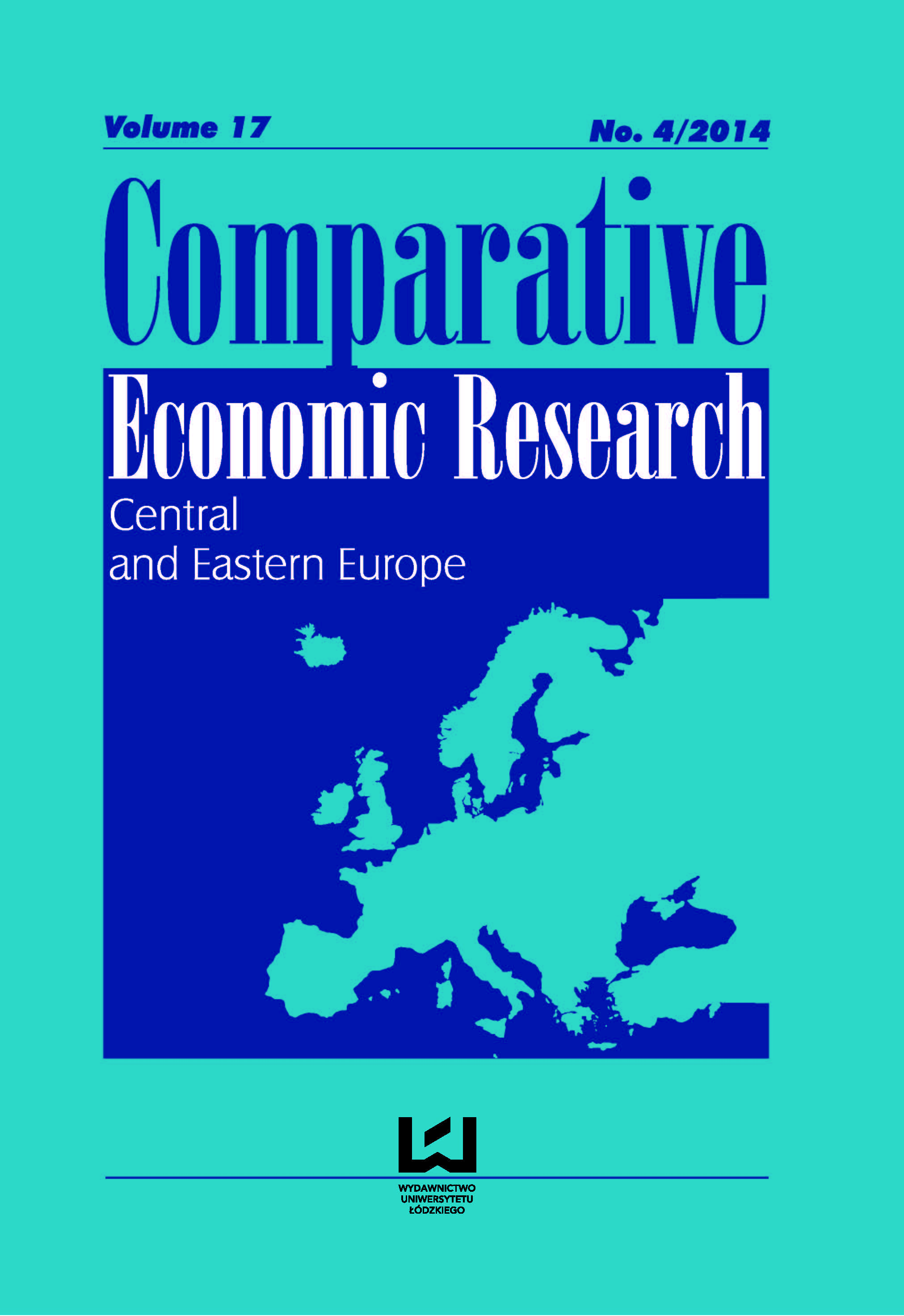The Application Of Local Indicators For Categorical Data (LICD) In The Spatial Analysis Of Economic Development
DOI:
https://doi.org/10.2478/cer-2014-0041Keywords:
join-count test, spatial dependence, local indicators of spatial association (LISA), exploratory spatial data analysis (ESDA), economic development, taxonomic analysisAbstract
The paper makes an attempt to apply local indicators for categorical data (LICD) in the spatial analysis of economic development. The first part discusses the tests which examine spatial autocorrelation for categorical data. The second part presents a two-stage empirical study covering 66 Polish NUTS 3 regions. Firstly, we identify classes of regions presenting different economic development levels using taxonomic methods of multivariate data analysis. Secondly, we apply a join-count test to examine spatial dependencies between regions. It examines the tendency to form the spatial clusters. The global test indicates general spatial interactions between regions, while local tests give detailed results separately for each region. The global test detects spatial clustering of economically poor regions but is statistically insignificant as regards well-developed regions. Thus, the local tests are also applied. They indicate the occurrence of five spatial clusters and three outliers in Poland. There are three clusters of wealth. Their development is based on a diffusion impact of regional economic centres. The areas of eastern and north western Poland include clusters of poverty. The first one is impeded by the presense of three indiviual growth centres, while the second one is out of range of diffusion influence of bigger agglomerations.
Downloads
References
Anselin L. (1988), Spatial Econometrics: Methods and Models, Kluwer Academic, Dordrecht.
Google Scholar
Anselin L. (1995), Local indicators of spatial association - LISA, ‘Geographical Analysis’, Ohio State University Press, vol. 27, issue 2.
Google Scholar
Arbia G. (2006), Spatial Econometrics: Statistical Foundations and Applications to Regional Convergence, Springer-Verlag, Berlin Heidelberg.
Google Scholar
Bivand R.S. et al. (2014), The spdep package of R, http://cran.r-project.org
Google Scholar
Bivand R.S., Pebesma E.J., Gómez-Rubio V. (2008), Applied Spatial Data Analyses with R, Springer, New York.
Google Scholar
Boots B.( 2003), Developing local measures of spatial association for categorical data, ‘Journal of Geographical Systems’, Springer-Verlag, no. 5, 139-160.
Google Scholar
Chojnicki Z., Czyż T. (1973), Metody taksonomii numerycznej w regionalizacji geograficznej, PWN, Warszawa.
Google Scholar
Cliff A.D., Ord J.K. (1973), Spatial Autocorrelation, Pion, London.
Google Scholar
Cliff A.D., Ord J.K. (1981), Spatial Processes: Models and Applications, Pion, London.
Google Scholar
Everitt B.S., Dunn G. (2001), Applied Multivariate Data Analysis, Arnold, London.
Google Scholar
Florek K., Łukaszewicz J., Perkal J., Steinhaus H., Zubrzycki S. (1951), Taksonomia wrocławska, ʻPrzegląd Antropologicznyʼ, Vol. XVII.
Google Scholar
Geary R. C. (1954), The contiguity ratio and statistical mapping, ʻThe incorporated Statisticianʼ, Vol. 5(3), pp. 115-145.
Google Scholar
Getis A., Ord J. K. (1992), The analysis of spatial association by distance statistics, ʻGeographical Analysisʼ, Vol. 24, Issue 4, pp. 189-206.
Google Scholar
Grabiński T. (1984), Wielowymiarowa analiza porównawcza w badaniach dynamiki zjawisk ekonomicznych, Akademia Ekonomiczna w Krakowie, seria specjalna: monografie, nr 61, Kraków.
Google Scholar
Grabiński T., Wydymus S., Zeliaś A. (1989), Metody taksonomii numerycznej w modelowaniu zjawisk społeczno-gospodarczych, PWN, Warszawa.
Google Scholar
Haining R. (2003), Spatial Data Analysis: Theory and Practice, Cambridge University Press, Cambridge.
Google Scholar
Hair J.F., Black W.C., Babin B.J, Anderson R.E., Tatham R.L. (2006), Multivariate Data Analysis, Pearson Prentice Hall, New Jersey.
Google Scholar
Hellwig Z. (1968), Zastosowanie metody taksonomicznej do typologicznego podziału krajów ze względu na poziom ich rozwoju oraz zasoby i strukturę wykwalifikowanych kadr, ʻPrzegląd Statystycznyʼ, R. XV, zeszyt 4, s. 307-327.
Google Scholar
Hwang C. L., Lai Y. J., Liu T. Y. (1993), A new approach for multiple objective decision making, Computers and Operational Research, No20, pp 889-899.
Google Scholar
Hwang C.L., Yoon K. (1981), Multiple Attribute Decision Making: Methods and Applications, Springer-Verlag, New York.
Google Scholar
Kolenda M. (2006), Taksonomia numeryczna. Klasyfikacja, porządkowanie i analiza obiektów wielocechowych, Akademia Ekonomiczna im. Oskara Langego we Wrocławiu, Wrocław.
Google Scholar
Kopczewska K. (2006), Ekonometria i statystyka przestrzenna z wykorzystaniem programu R CRAN, Cedewu, Warszawa.
Google Scholar
LeSage J., Pace R.K. (2009), Introduction to Spatial Econometrics, Chapman & Hall/CRC, Boca Raton.
Google Scholar
Łuczak A., Wysocki F. (2011), Porządkowanie liniowe obiektów z wykorzystaniem rozmytych metod AHP i TOPSIS, ʻPrzegląd Statystycznyʼ, Vol. LVIII, Issue 1-2.
Google Scholar
Markowska M. (2012), Dynamiczna taksonomia innowacyjności regionów, Uniwersytet Ekonomiczny we Wrocławiu, Wrocław.
Google Scholar
Nowak E. (1990), Metody taksonomiczne w klasyfikacji obiektów społeczno-ekonomicznych, PWE, Warszawa.
Google Scholar
Paelinck J.H.P., Klaassen L.H. (1979), Spatial Econometrics, Saxon House, Farnborough.
Google Scholar
Pietrzak M.B, Wilk J,. Kossowski T., Bivand R. (2014), The identification of spatial dependence in the analysis of regional economic development - join-count test application, [in:] Papież M., Śmiech S. (Ed.), Proceedings of the 8TH Professor Aleksander Zelias International Conference on Modelling and Forecasting of Socio-Economic Phenomena.
Google Scholar
Pluta W. (1976), Wielowymiarowa analiza porównawcza w badaniach ekonomicznych, PWE, Warszawa. Strahl D. (ed.) (2006), Metody oceny rozwoju regionalnego, Wyd. Akademii Ekonomicznej we Wrocławiu, Wrocław.
Google Scholar
Suchecka J. (ed.) (2014), Statystyka przestrzenna. Metody analiz struktur przestrzennych, C.H. Beck., Warszawa.
Google Scholar
Suchecki B. (ed.) (2010), Ekonometria przestrzenna. Metody i modele analizy danych przestrzennych, Wydawnictwo C.H. Beck, Warszawa.
Google Scholar
Tobler W. (1970), A computer movie simulating urban growth in the Detroit region, ʻEconomic Geographyʼ, Oxford University Press, No 46(2), pp. 234-240.
Google Scholar
Walesiak M. (1993), Strategie postępowania w badaniach statystycznych w przypadku zbioru zmiennych mierzonych na skalach różnego typu, ʻBadania Operacyjne i Decyzjeʼ, No 1, pp. 71-77.
Google Scholar
Wysocki F. (2010), Metody taksonomiczne w rozpoznawaniu typów ekonomicznych rolnictwa i obszarów wiejskich, Uniwersytet Przyrodniczy w Poznaniu, Poznań.
Google Scholar
Yoon K. (1987), A reconciliation among discrete compromise situations,Journal of Operational Research Society, No 38, pp. 277-286.
Google Scholar
Downloads
Published
How to Cite
Issue
Section
License

This work is licensed under a Creative Commons Attribution-NonCommercial-NoDerivatives 4.0 International License.











